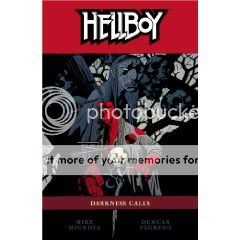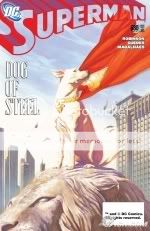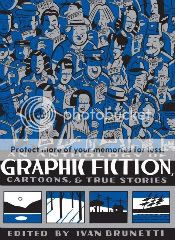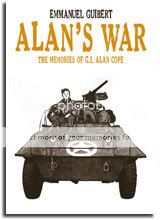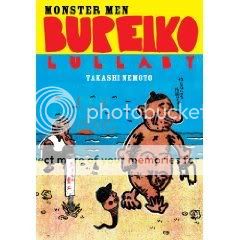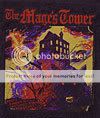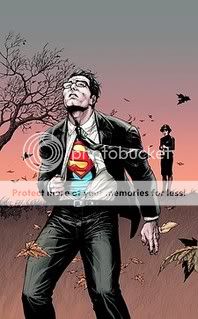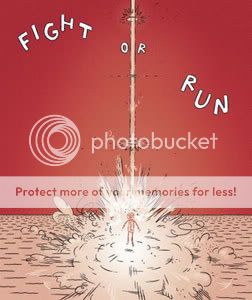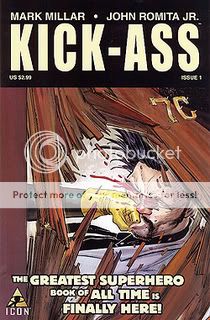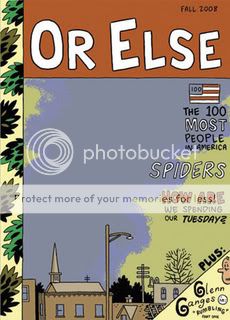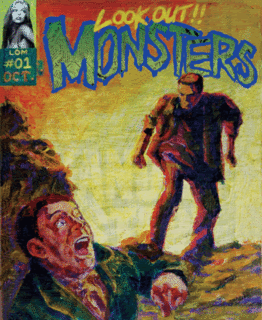Posts Tagged ‘Comics Time’
Comics Time: Hellboy Vol. 8: Darkness Calls
November 14, 2008Hellboy: Darkness Calls
Mike Mignola, writer
Duncan Fegredo, Mike Mignola, artists
Dark Horse, 2008
200 pages
$19.95
I think B.P.R.D. is better than Hellboy at this point, whether or not Mike Mignola himself is drawing either one. With John Arcudi as co-writer and Guy Davis on art, B.P.R.D. has that mix of action, horror, sly black humor, and quietly but genuinely unnerving fatalism that has long characterized Hellboy at its best, with art that is totally different than Mignola’s yet in many ways equally accomplished and evocative. But now it’s more grounded in things you can grasp and understand than Mignola’s increasingly unfettered “main” series–there are still recognizable human concerns, likable characters, and dramatic stakes at play, rather than Hellboy punching his way through esoteric world mythologies inhabited by an increasingly prodigious cast of hard-to-discern faerie-demon-god-witch-ghost things. I also think that of all Mignola’s recent artistic collaborators, Duncan Fegredo is doing my least favorite work; that’s a pretty faint damnation since it’s still pretty good, but there’s something about the way he apes Mignola but throws in more lines and details that just doesn’t satisfy the way the work of Mignola himself or the not-at-all-imitative work of Guy Davis does.
All that being said, you know what? I reread this graphic novel the other night and had a grand time with it. In large part, I think that’s because reading it all between the same set of covers in one sitting enabled me to finally figure out what the hell is going on! Basically, Hellboy’s living in the estate of a very old friend of his mentor’s. He goes out for a stroll and happens across a trio of weirdos who turn out to be the anthropomorphized familiars of medieval witches slain by a witchfinder-general type. They resurrect their old mistresses, but the witchfinder guy still haunts the area and attacks. The familiars split. Witchfinder-zombie kills two of the witch-zombies, but the third snags Hellboy and brings him to a big meeting of all of England’s witches. They’re seeking a new ruler, since the witch-queen Hecate was previously vanquished by Hellboy and was since unsuccessfully resurrected by a half-man half-devil named Igor Bromhead who tried and failed to take her powers for his own. They ask Hellboy to be their king, and he says no. A servant of HB’s old enemy, the Russian mythological baddie Baba Yaga, offers to take HB off their hands by way of vengeance for his spurning their offer, so that Baba Yaga–another HB vanquishee–can get her own revenge on him. They say yeah sure, so HB finds himself in the dreamworld-Russia of Baba Yaga, who sics an army of skeletons and an immortal warrior named Koschei the Deathless on him. She promises to let Koschei die if he kills Hellboy–she has possession of his soul–but I guess it turns out that Hellboy can’t be killed in this dimension either. (Or maybe not at all?) While Baba Yaga does manage to kill Perun, the pagan Russian god of the earth, her and Koschei keep coming up empty against Hellboy himself. With the help of a spirit of the forest, a little house-elf type guy, and a creepy little girl who once used a gift from Baba Yaga to kill her abusive step-family, Hellboy keeps schooling Koschei, who keeps getting revived by Baba Yaga, but each time she does so she throws more and more of her own power into him. Finally she runs out of juice (even tossing old Rasputin’s soul into the mix), but in one last-ditch effort she gets Koschei to lob a knife into Hellboy’s back. This still doesn’t work, but it makes HB drop a magic piece of paper the creepy girl gave him, which turns into an ocean and allows him to swim back to the real world. There he dispatches that witchfinder-zombie from earlier on. That guy’s sword is inscribed with the name of Igor Bromhead, the half-man reptile dude who we saw swing and miss in his attempt to take Hecate’s powers as his own. Turns out he’s been slithering around Italy eating sheep and things ever since. Hellboy kills him but not before he can get out a prophecy about HB leading Hell’s army, which after all is HB’s whole reason for being around. This ties into something one of Baba Yaga’s undead Russian comrades told her earlier–that Hellboy wasn’t “ready” to give her an eye in exchange for the one he poked out of her years ago, but the implication being he might one day. Meanwhile, as all this is going on with Hellboy, a little pig-guy named Gruagach has pitched the witches on resurrecting a mysterious “HER” to use as their new queen now that Hecate is out of commission and Hellboy is a non-starter. He and some minions find this big giant who’s in charge of keeping this mystery lady’s pieces in a box in a deep dungeon and explain that the witches want the box. The giant gives it to him but then crawls into the dungeon himself since he wants no part of the bad stuff that will go down once whatsername gets loose. On their way back to the witches Gruagach and his pals come across Dagda, who I think is king of the faeries or something and who doesn’t want them to open the box. One of the minions kills him and then feels terrible about it and kills himself. Gruagach proclaims to assembled faeriedom that whoever’s inside the box will now be their queen as well. Then there’s a pair of epilogues: In the first, the BPRD gets their first letter from Hellboy in six years, just a quick note telling them where he’s hanging out now. They realize that the old friend he’s been staying with has been dead for 24 years or so. Uh oh! In the second epilogue, an old witch-hunter-type guy we’ve seen mentioned here and there named Edward Grey does a seance with Hecate to ask her life story, and she explains that she once upon a time helped ruin the proto-kingdom of Hyperborea by delivering unto them promethean knowledge of the workings of the universe that she stole from the fallen angels its ruler had penned up. (It’s kind of a Sauron/Numenor deal.) She makes it sound like it’s going to be Grey’s mission to stop Hellboy from unleashing the apocalypse (her included), which she says Hellboy will not survive regardless. The end!
Okay, I got a few things out of writing down that summary. First, now I think I finally understand what happened. Second, it becomes obvious that this story is waaaaay too convoluted, even for Hellboy. There’s upward of a dozen factions at work, each trying to do something that’s a little ambiguous and mysterious to begin with. Put it all together and it’s borderline incomprehensible–you can’t tell the players without a scorecard, and unless you sit and bang one out like I just did, none is forthcoming. Third, the art really doesn’t help. Fegredo’s spin on Mignola is already a little too manic and cluttered–he admits in the sketchbook section reprinted in the back that he’s not really adept at spotting blacks, certainly not on the level Mignola is–and a lot of it hits your eyes and brain as a wall of noise. Meanwhile, a lot of the different characters are pretty hard to tell apart–I thought the pig guy was part of the cat/frog/bird crew, i thought piggy’s minions were Baba Yaga’s minions, I thought the faeries were the witches, and on and on and on. Add these problems to the already murky plot, and whoo doggie.
But I mentioned the fatalism of the Hellboy books earlier, and I think that’s what comes through the strongest here for me. The Hellboy-proper comics have flirted with incomprehensibility for quite some time, so that’s really no surprise; what is sort of surprising to me, given how ongoing genre titles usually work, is that Hellboy and the BPRD seem to be headed for an unhappy ending. When you think about it, ever since Hellboy left the BPRD and struck out on his own, the status quo for both halves of the equation has actually gotten worse with the close of each new adventure. This story all but says that Hellboy, our cute sardonic two-fisted hero, will indeed become the Beast of the Apocalypse he was born to be. That’s what I take away from Darkness Calls–that underneath the sea of crazy that flows from humanity’s collective unconscious, underneath the haze of mythology and Lovecraft that Mignola is increasingly untethered in, something terrible is happening. That’s a fine, black beating heart for powering a mythos.
Comics Time: Superman #677-680
November 12, 2008Superman #677-680
James Robinson, writer
Renato Guedes, artist
DC Comics, 2008
32 pages each
$2.99 each
James Robinson’s still-young run on Superman, of which these issues comprise the opening arc, is an odd duck among my superhero-reading friends. As far as this group is concerned in today’s superhero-publishing climate, there’s usually a pretty clear consensus as to which titles are good and which ones aren’t. Allowing for outliers in terms of people who really like Jason Aaron or just can’t get into Grant Morrison or something like that, a real schism is rare. Superman has provoked just such a schism.
If you ask me to judge based on this storyline–okay, extended fight scene in the shape of a storyline–it’s pretty good! I can understand how some of the things Robinson is doing could throw some people. For instance, he’s writing this weirdo staccato dialogue, particularly in the first-issue conversations between Superman and Green Lantern and the various members of the Science Crimes Unit. It’s strange sub-Bendis pseudo-Mamet-noir stuff that neither sounds like how people actually talk nor makes up for that with sufficient style; you’d expect it out of a real newcomer, not a storied veteran of high-end superhero comics like Robinson.
But those hiccups sort of dwindle away after a while, and you’re left to focus on the things that work. Provided you’re like me and your ideal Superman comic is like if primary colors could punch each other, there’s plenty. I’ve been a fan of Renato Guedes’ open, strangely delicate linework and character designs back when he co-drew Geoff Johns and Kurt Busiek’s memorable “One Year Later” (remember that?) Superman/Action Comics arc Up, Up, and Away!–still one of the two or three best Superman stories I’ve ever read–and he’s in fine form here. His characters are warm and believable, yet he also cartoons, particularly in several fine combat sequences. Hi-Fi’s colors give the musclebound proceedings a purple-pink hue that suggests both vulnerability and tumescence, which is what I for one want out of my superhero slobberknockers.
Meanwhile, the whole idea of the story–big huge dude shows up, should be a standard “Superman vs. brick” battle that Superman wins handily, but it turns out he’s getting his ass handed to him and him and his friends have to figure out why before he gets killed–is a clever twist on the usual “Superman vs. villain of the month” stuff that I always thought was the lamest aspect of the modern-era version of the character, given that, y’know, he’s Superman and it’s tough to convince us he’s in danger very often. (Kudos on that score have to go to Johns, who’s been reliably tuning up Superman’s classic rogues gallery for quite a while now.)
Superman’s main antagonist in this story is the forgotten Jack Kirby creation Atlas. Naturally I’m in favor of bringing back any and all ’70s Kirby characters to the forefront of the line, especially in a way that sort of captures how powerfully written and drawn they all were by instantly making them major threats. That’s what Robinson and Guedes do here, including a shattered-memory origin sequence drawn in Kirby’s style; trying to figure out how Atlas went from heroic but rageful Kirby barbarian to single-minded heel turns out to be key to the story. If, like me, you had no idea who this Atlas guy was before seeing him here–I just thought he was an attempt to take the Atlas character from Grant Morrison’s All Star Superman and make him canon–you’ll enjoy him just fine anyway.
All things considered, I’m suddenly a lot more excited to see Robinson trade eights with Johns during the just-launched New Krypton Super-event. I’m really rather pleased with several of DC’s core properties at the moment, in fact; it’s just nice to see someone whose initials aren’t GJ or GM contributing.
Comics Time: An Anthology of Graphic Fiction, Cartoons, and True Stories
November 10, 2008An Anthology of Graphic Fiction, Cartoons, and True Stories
Ivan Brunetti, editor
Robert Armstrong, Peter Bagge, Lynda Barry, Gabrielle Bell, Marc Bell, Jonathan Bennett, Mark Beyer, Mat Brinkman, Chester Brown, Jeffrey Brown, Ivan Brunetti, Charles Burns, Daniel Clowes, David Collier, Robert Crumb, Henry Darger, Gene Deitch, Kim Deitch, Julie Doucet, Michael Dougan, Debbie Dreschler, Lyonel Feininger, Phoebe Gloeckner, Justin Green, Bill Griffith, John Hankiewicz, Sammy Harkham, Rory Hayes, David Heatley, Sam Henderson, Gilbert Hernandez, Jaime Hernandez, George Herriman, Walt Holcombe, Kevin Huizenga, Crockett Johnson, J. Bradley Johnson, Ben Katchor, (pause for breath), Kaz, Frank King, James Kochalka, Aline Kominsky-Crumb, Harvey Kurtzman, Jason Lutes, Frans Masereel, Joe Matt, David Mazzuchelli, Richard McGuire, Tony Millionaire, Jerry Moriarty, Mark Newgarden, Onsmith, Gary Panter, Harvey Pekar, John Porcellino, Archer Prewitt, Daniel Raeburn, Ron Regé Jr., Joan Reidy, Joe Sacco, Richard Sala, Charles M. Schulz, Seth, R. Sikoryak, Otto Soglow, Art Spiegelman, Cliff Sterrett, James Sturm, Adrian Tomine, Carol Tyler, Chris Ware, Lauren R. Weinstein, Wayne White, Karl Wirsum, Jim Woodring, Terry Zwigoff, writers/artists
Yale University Press, 2006
400 pages
Price
Buy it from Yale University Press
I have to admit I’m a little tempted just to let the contributor list for this anthology serve as my review. I mean, look at that thing! And indeed I think I’d be somewhat justified in doing so. If the purpose of this anthology is to demonstrate the depth and breadth of style and effect possible in the comics medium as evinced by its best practitioners, well, the defense rests, you know? Provided your non-comics-reading buddy is a short-story guy rather than someone who needs a big long self-contained tale for their fiction fix, this book is an A-#1 Christmas gift.
But the strengths of this first volume in what I sincerely hope will be a long series of Ivan Brunetti-edited comics anthologies published by my alma mater go beyond the names in the table of contents. (Where they aren’t listed at all, now that I think of it–Onsmith provides an illustrated TOC featuring drawings of the main characters in each story or strip.) As a curator, Brunetti knows not just who to include, but nine times out of ten what to include from them. Therefore, your Jaime Hernandez story is his masterpiece, “Flies on the Ceiling.” Your Ron Regé Jr. contribution is drawn from his little seen, much loved, then-uncollected collection of haiku-like sex comics with Joan Reidy, Boys. Your Dan Clowes story is motherfucking “Gynecology.” Mark Newgarden’s “Love’s Savage Fury.” Phoebe Gloeckner’s “Fun Things to Do with Little Girls.” Richard McGuire’s “Here,” an ass-kicker if ever there was one. Kevin Huizenga’s “A Sunset” (albeit just an excerpt, which sort of dilutes the power of what to me is the comic of the decade, but still!). The sense I get is of Brunetti in front of his bookcases, selecting what should go into the anthology based on which sections of which comics are the most dogeared, read and re-read, loaned out and repurchased. It’s like when your friends come over and you go “oh man, you’ve gotta read this one!”
But it’s not just a collection of shorts that run one into the next haphazardly–it’s like the really well-made mixtape of comics anthologies. I was intrigued to read in Brunetti’s introduction that he ordered the comics roughly by length, starting off with mostly gag-driven one-pagers and ending with long stories and excerpts. That’s a smart and engaging structure in that the books trains you to read it as you go along, starting simple and gradually growing more demanding. Within those overall parameters Brunetti frequently arranges his selections in noticeable sub-sections, determined either by subject matter or artistic style: there’s a crosshatcher’s club with Robert Crumb, Joe Sacco, and David Collier; a childhood trauma section with Justin Green, Phoebe Gloeckner, and Debbie Dreschler; the Three Amigos of Canadian Comics, Joe Matt, Chester Brown, and Seth; an outsider-influenced section kicking off with Henry Darger and Rory Hayes and continuing through Aline Kominsky-Crumb, Mark Beyer, and Mat Brinkman; a Jewish ghetto of Julius Knipl, Maus, Berlin, and The Golem’s Mighty Swing; and whether this is intentional or not, closing with Chris Ware and Dan Clowes seemed a deliberate crowning of those two artists as the giants of the modern era of comics, which I personally have always thought them to be. If I’m making this sound easy or rote, I don’t mean to at all, by the way. Discovering what section you’ve just read your way into is a lot of fun, a big part of the pleasure of the collection.
Now, to draw pleasure from the collection in the first place, it probably goes without saying that you must be capable of drawing pleasure from astute depictions of misery. I’m sure there are broadsides against this book out there from people who want a little less dreary awfulness in their funnybooks than you’re going to get from the contributors listed above. I think this complaint has some justification. The near-total lack of genre material of any kind, save only the horror-tinged monster-y comics of Jim Woodring, Mat Brinkman, Rory Hayes, and Charles Burns, offers a somewhat lopsided frame through which to view what people do with comics, narratively and emotionally. You’re basically dealing with sadness and black comedy, with the occasional gross-out gag and “gosh weren’t things beautiful in the olden times” nostalgia to leaven it a little. Of course, nostalgia and misery go hand-in-hand for many of these comics, particularly for the memoirists–between Seth, Crumb, Joe Matt, and several tributes to Peanuts, you will probably get tired of cartoonists complaining about how ugly and awful their lives are compared to their old clothes/houses/comics/records/etc. General self-pity is a running theme, too, and while the occasional cartoonist manages to convey it in a novel fashion–Ware’s flat-affect trip down memory lane, incongruously set to a mocked-up Golden Age superhero comic–there’s no way to get around the fact that you’re gonna see a lot of funny lookin’ dudes in glasses kvetching about themselves with a lot of exclamation points. I’ve never minded that tendency in the overall altcomix gestalt all that much, but when you put a lot of it between two covers, it gets harder to ignore and sometimes harder to take. And even when the nostalgic elements are presented as-is, those presentational choices can be a bit cloying. Most of the old-time newspaper strips we see, for example, are reproduced Chip Kidd-style as photos of the original pages rather than, you know, just taking the comics themselves and putting them on the page. Presenting old comics as fetish objects dulls their impact, whatever else doing so may have going for it–“Here’s a Chris Ware strip, here’s a Charles Burns strip, and here’s something I found in my grandpa’s attic.” Similar moves done to emphasize the unique publishing circumstances of more recent projects–throwing a photo of a Jonathan Bennett minicomic in front of the actual strip contained therein, reproducing Jeffrey Brown stuff by photocopying them straight from the tiny diary-like books he originally draws them in–are sort of haphazardly done and to minimal understandable effect.
But none of that really takes much away from the impact of the collection, for all of the above reasons and one more: Is there something to be gained from having so much work from so many different artists all in one place, even when many or even most of them already grace your bookshelves? Sure, and it’s gained through juxtaposition. I found myself noticing all kinds of things about work I already knew pretty well–Joe Sacco’s art runs full-bleed. R. Crumb’s “trademark” style shifts far more radically than I’d ever noticed. You really can see Hayes in Kominsky and Beyer. In all honesty I feel like I got as much out of this book as any newbie might. That’s the mark of a great anthology.
Comics Time: Bone
November 7, 2008Bone
Jeff Smith, writer/artist
Cartoon Books, 2004
1,344 pages!!!
$39.95
Rarely have I gone less far out on a limb than by calling Jeff Smith’s “cartoon epic” Bone universally beloved. One need look no further than the acknowledgments page, which offers sincere thanks to supportive comics-industry players ranging from Marv Wolfman to Art Spiegelman, Harlan Ellison to Craig Thompson, Wizard to The Comics Journal. Frankly it’s not tough to see why everyone’s wild about the thing. A lushly drawn and ostentatiously cartooned fantasy epic starring funny animals self-published over the course of 12 years? There’s really something for everybody in there.
Let’s start with the part that wasn’t for me: The cutesy comic business left me flat for the entirety of the saga. Simply put, this book didn’t make me laugh out loud a single time, and given how much of it is dedicated to supposed-to-be-funny schtick involving the titular Bone cousins, rustic villagers, cowardly rat creatures and so on–especially in the early going–I think that’s a real problem. To be honest, if this wasn’t BONE, if I hadn’t been hearing about it for as long as I’ve read comics, I wouldn’t have gone much further than the opening chapter or two. I think there was one gag that kinda made me snort, but now I have no idea what that was, which is revealing in its own way. (It certainly wasn’t the recurring bit about quiche.)
Obviously, what draws you in and keeps you involved even when the “Tolkien as Saturday morning cartoon on Nick Jr.” humor drags on is Smith’s cartooning. I know I tend to tout character design a lot on this blog, but the effortlessly classic looks Smith comes up with for his major players are almost in a class by themselves. I’m not saying they’re necessarily all brilliant or innovative–there’s a certain slick Disneyness to a lot of it–but in a way that’s the selling point right there: These characters and creatures look like you’ve been seeing them all your life. The droopy-eyed, floppy-eared Great Red Dragon; Mammy Yokum-esque Gran’ma Ben; giant, dead-eyed, rictus-grinned Kingdok (he’s like a huge furry Jaws!) and his rat-creature minions; the eerily faceless Hooded One and the solemnly robed stick-eaters; gorgeous, shaggy-haired Thorn, especially early on; and the part-Pogo, part-Snoopy, part-Smurf, all-Bone Fone, Phoney, and Smiley…that’s a helluva batting average. Having characters that unimpeachably solid running around makes the narrative all the more seductive–a must when you’re dealing with something this long and sprawling.
But you know, sprawling might not be the right word. It is a massive, massive story, and God only knows what it felt like to read it parceled out in individual issues over the course of a decade rather than in single volume that’s heavier than my laptop computer. Even still, each chapter moves rather smoothly and inexorably into the next, like a prose fantasy epic would. This is a very different reading experience than a 1300-page collection of even the most cohesive superhero-comic run, where individual stand-alone issues and even storyarcs would diverge from the main narrative. And again, I think this linearity is a necessity for what Smith is trying to accomplish. Over the course of the story there is a pretty massive tonal drift, but looking back, I couldn’t pinpoint precisely when it happened; all of a sudden you look around and the line is thinner and harsher, the pages look speckled with dust and debris versus the clean black and white of earlier chapters, and the story has gone from cow-racing and meet-cutes to internecine warfare between religious orders and attempts to thwart the beast of the apocalypse. This is accomplished with such a lack of herky-jerky shifts and seams that you hardly even notice it happening until it’s already happened.
Does Smith fall back on standard fantasy archetypes and narrative tropes to do some of this work for him? Of course. The whole set-up–cute, diminutive, innately noble little guy and his cousins do the fish-out-of-water thing to save the tunic-wearing folk and secret, hidden royalty of a fallen kingdom against a resurgent and vengeful dark lord–is lifted directly from The Lord of the Rings. And as the common complaint against that work goes (a complaint I’ve never shared, but then I have the White Tree of Gondor tattooed on my arm, so I probably wouldn’t), Bone‘s early, comparatively inconsequential chapters feel drawn out while the conclusion seems rushed. As I said, lingering on the unfunny comic business of the hapless Bones learning the rules of the road in the fantasyland they’ve stumbled across is a real obstacle to enjoying the book; by the end that stuff is mostly gone and replaced with what is to me a much more fun fantasy war/adventure story, but not even a geek like me is blind to how many key plot points there at the end are revealed through dreams and visions rather than earned, for want of a better word, and how rapidly key enemies and obstacles are overcome.
Unsurprisingly, Smith’s fantastical worldbuilding and storytelling shine brightest at their most idiosyncratic, from both a narrative and artistic standpoint. We’ve all seen hooded, faceless villains before–again, see Tolkien–but when Smith’s Hooded One speaks, the word balloons seem to ooze directly from the cavernous folds of the hood. I wasn’t 100% sold on doing cartoony dragons instead of dragons who are actually scary and intimidating, but then you get a look at the whole dragon bestiary, and seeing every possible variation of cartoony dragon gives the concept a dizzying, zany punch. The creation myth and cultural hierarchy Smith devises are personal enough to somewhat transcend the elements they share with countless other such mythoi. I’m still trying to figure out why the giant mountain lion Rockjaw comes to dominate the middle third of the book and then reappears later to do…nothing; he’s like the book’s somewhat sinister version of Tom Bombadil. And there’s one really chilling, batshit crazy sequence where the theocratic tyrant ruling over the abandoned kingdom confronts the Hooded One, only to be completely one-upped and outclassed in the insane and hideous and violent departments–that one will stick with me for a long time. The final fate of the big adversary was also quite memorably done–I saw the basic contours of that confrontation coming, but their final shape was not one I predicted at all.
I found reading Bone in a short timespan over these years to be a pretty engrossing experience, all told. Particularly toward the end, I’d anxiously look forward to my next train ride or pre-bedtime read to find out what happens next. But it never knocked my socks off, which seems to be what this kind of story is meant to do. I’m glad I read it, but had I never done so I think my life would have gone on just fine. There’s no tattoo of the Crown of Horns in my future.
Comics Time: Alan’s War
November 5, 2008Alan’s War
Emmanuel Guibert, writer/artist
First Second, November 2008
336 pages
$24
You immediately judge Alan’s War against two separate non-fiction genres: World War II books and graphic memoirs set against major historical backdrops. You’ll find it a low-key affair when stacked up against either. Culled from “The Memories of G.I. Alan Cope,” as Guibert’s subtitle puts it, Alan’s War is as different from, say, Ken Burns’s The War as the possessive proper noun is from the definite article. As a matter of fact, Alan is barely in the war; the vast majority of his recollections are of times before or after his entry into hostilities, such as it was. To hear Alan tell it, he appears to have been involved in combat only one time and never saw his attackers. The most horrific incidents he recounts both took place during Germany’s surrender. It’s not D-Day or Iwo Jima by a long shot. Nor is it Maus, where Vladek’s experiences spoke directly to the central horror of the war. Nor even is it Persepolis, where Marjane’s forceful personality made the conflict with Revolutionary Iran feel a lot more direct than events actually bore out. Instead it feels a lot more like Siberia, a sort of meandering, matter-of-fact presentation of a gentle soul who couldn’t help but butt up against a cataclysmic world-historical scenario. In Siberia’s case the inhumanity of the totalitarian USSR was really just another challenge for Nikolai Maslov’s depressive personality; in Alan’s War, life in the Army simply pushes Alan in a different direction but still is primarily viewed through the lens of the friendships it enables him to form. We come to see that interpersonal relationships are the way Alan learns about himself throughout his long life, culminating in a spiritual and philosophical “rebirth” late in his life owed to acquaintances he made in occupied Germany. This particular narrative throughline is obviously constructed by Guibert’s editing of Alan’s story, which begs perhaps the most interesting unanswered question in the book, that of Alan’s possible homosexuality. The frequency with which Cope’s reminiscences star friends and fellow soldiers coming to terms with their own identity led me to wonder whether that was the one act of self-examination the kindly intellectual was never quite able to perform on himself. In its way Alan’s War is an compelling little book, its idiosyncratic protagonist going a long way to humanize art that is occasionally static and obviously photoreffed in the way that those rotoscoped credit card/financial adviser/whatever they are commercials that subtract a bunch of lines from a person’s photo can look, but is just as frequently endearing in its simplicity.
Comics Time: Siberia
November 3, 2008Siberia
Nikolai Maslov, writer/artist
Soft Skull Press, 2006
98 pages
$19.95
Originally written on November 1, 2006 for publication in The Comics Journal
Martin Scorsese’s Casino ends with narrator Sam “Ace” Rothstein declaring of the story he’s just told, “And that’s that.” There’s nothing that straightforward and simple about the movie itself, which is an absolute masterpiece of excess; but as an imaginary capstone to Nikolai Maslov’s memoir of Communist life Siberia, it works perfectly. From Maslov’s barely-there pencils-only art to his story’s episodic “and then this happened, and then this happened, and then this happened” structure, everything about this graphic novel evokes the feeling that Maslov is telling his tale not to find meaning within it, but to ascribe meaning to it – as if the simple act of recounting a life of grinding poverty, ubiquitous alcoholism, mental illness, and utter hopelessness will lend it a purpose that the Soviet structure relentlessly denied it. Maslov’s figure work and portraiture are startlingly effective; they never rise too far above the level of “very talented high-schooler,” but the pathetic ugliness of nearly all of his characters, including himself – they all look mildly retarded – is an almost perfect mechanism for chronicling a life and a society gone sour. The intimacy of the art’s soft gray makes some of the sourest moments, like the scene in which an alcoholic peasant literally laps spilled wine up off the ground, an almost unbearable intimacy. Siberia lacks the sort of narrative through-line that characterizes most memoir writing, which can be both a curse and a blessing. Like a Harvey Pekar of Stalinism, Maslov doesn’t always convince us that these anecdotes are worth relaying. But there’s an undeniable frisson to be found in the fact that he and the rest of Russian society escaped from the grip of authoritarianism – if, as is now apparent, only for a little while – to relay them at all. That seems to be Maslov’s message, to the extent that he has one beyond trying to come to terms with his own life. And that’s that.
Comics Time: Monster Men Bureiko Lullaby
October 31, 2008Monster Men Bureiko Lullaby
Takashi Nemoto, writer/artist
PictureBox Inc, September 2008
200 pages
$19.95
What even to say about Monster Men Bureiko Lullaby? It’s the kind of book that sets up a “get it/don’t get it” dichotomy almost automatically. There’s very little in terms of traditional parameters against which you can weigh the endless parade of transgression and revulsion, the shit-eating and child rape, the cancer and mutilation, the squiggly, cluttered line and resolutely ugly characters and environments. Unlike Johnny Ryan’s work, it doesn’t use the gross-out constituent parts to build up jokes–and I’m not just talking Ryan’s more straightforward gag strips and funny stories, I mean it doesn’t even go in for the super-labrynthine, Pythonesque digression structure of some of Ryan’s recent-ish stuff–nor, of course, does it share Ryan’s lovely, classically influenced line. Unlike the work of Rory Hayes, it doesn’t convey that sense that you’re seeing someone’s searing, indelible, personal artistic vision–there’s no unique vocabulary of teddy bears and demons, no electrocuted lines that look like they radiated directly out of the artist’s brain.
Perhaps appropriately, what it most feels like to me is someone excreting their id all over the pages, paying virtually no attention to anything other than simply pooping out every horrible thought in his head. It’s like…if someone who was already kind of gross had their self-censoring mechanism surgically removed, and then did a week’s worth of 24-hour comics in a row. The initial suite of short stories–starring a man whose penis takes over his body, flipping it over so that the guy walks on his hands as his dick and balls take on the shape and skills of a face; an idiot-savant artist whose only subject is his penis, which he cuts off and sends to a girl he sees peeing as an attempt to mitigate her tragic penislessness; and “the world’s most mature baby,” who begins fucking his own mother while still in the womb–are somewhat disjointed in effect, eschewing storytelling rhythm for a pile-up of excess. The book’s epic centerpiece, the two-part “The World According to Takeo,” really is more in the vein of an improvised 24-hour comic–in an interview with PictureBox’s Dan Nadel included in the volume, Nemoto says he started the comic with a few simple themes and no idea of how it was going to proceed or end in mind. It meanders, escalates, and by its second part coheres into something more sophisticated than the rest of the material here: The presence of readily understandable themes like the relationship between sexual abuse and sex work, or the reveal of the main character, the sentient sperm Takeo, as a the pretty benighted but at least recognizable homosexual stereotype, give the formless outrageousness something to work against. Of course, you’re still talking about a comic co-starring a serial rapist who eventually dies of cock cancer.
This is not to say that there’s no legible philosophical content in here. Japan’s complex and at times disgraceful treatment of the victims of Hiroshima and Nagasaki and their descendants is an obvious reference point. I certainly think it’s more powerfully dealt with here than in the staid Town of Evening Calm, Country of Cherry Blossoms. Since the book savages anything it touches, both the victim analogues and the society that shuns them are treated viciously; in that sense it not only critiques but embodies that problematic stance–that’s honesty, I suppose. You also can’t help but feel that Japanese society’s simultaneous prurience and prudery–sexualizing schoolgirls but never depicting penetration in pornography, for example–is the target of the extravagantly outré sexualized violence on display here.
But the question is, is being deliberately without virtue a virtue? At what point does artlessness become an art in itself, and at what point does it simply remain artlessness? Down at the bottom of my sidebar you’ll see the phrase “KEEP COMICS EVIL.” Monster Men Bureiko Lullaby certainly does that. Is it enough? I know that for me, sometimes simply being offensive, thumbing your nose at polite society, feels like a tremendous victory, a nihilistic triumph. Yet at other times it makes me want to ask, “Is that all there is?” Which is it? I…I give up.
Comics Time: The Mage’s Tower
October 29, 2008The Mage’s Tower
Lane Milburn, writer/artist
Closed Caption Comics, 2008
28 pages
$10
Horror comedies are often neither all that horrific nor all that comedic—and that’s just at the movies. “Funny” “horror” comics, the kinds of things that fill out the Previews section of many an Image Comics wannabe, are frequently among the most aggressively useless books on the stands. So The Mage’s Tower is sort of like rooting through your junk drawer and finding fifteen grand in crisp hundred-dollar bills. Lane Milburn not only has killer comedic timing, he also has great horrific timing, which is essentially the same thing–knowing just when to deploy a certain image to maximize its impact–but done in the service of the bizarre and disturbing.
This lovely-looking screen-printed minicomic contains three stories rooted in Milburn’s customary Black Sabbathy monsters and demons idiom. “Lugubrious Dunes” centers on the slacker son in a family of grotesques who embarks on a quest to kill some Gamorrean Guard types and get it on with a princess who has the head of a lizard–but it turns out this is all a fantasy, soon interrupted by his haranguing mother, who summons the kid to a “family dance meeting” that’s as ridiculous as it sounds. “Fisticuffs” is a page of just that, starring two creepy brutes with amusingly incongruous, slender swan heads as they duke it out in a fight that ends as rapidly as the one where Kimbo Slice got his ass handed to him in 20 seconds.
The third, final, centerpiece story, the one that really impresses you with the ingenuity of its concept and freshness of its execution, is “The Mage’s Tour.” The play-on-words in the title of the story compared to the title of the comic itself is really the big reveal–we follow two hooded and cloaked beings on what looks like an attempt to storm a villain’s fortress, but that fortress turns out to have been turned into a modern-day tourist trap by said villain, which is what the heroes have come to put a stop to. As the comic plays out, the battle between our heroes and the apostate they’ve come to thwart is intercut with reactions from a tour group who think it’s all part of the act. So as Milburn’s greasy line presents us with increasingly dynamic action and monstrous effects–like Mat Brinkman prints at their most heavy-metal–we keep getting the occasional cutaway to a guy trying to teach his wife how to use the cameraphone to take pictures of the battle and things like that. (“And then I download it?” “Umm…what do you mean?” It’s like a cameo from my mom!) There’s even a laugh-out-loud punchline that gets its own three-color splash page at the end of the book.
This cat’s good. Keep a close eye on him.
Comics Time: Daybreak Episode Three
October 27, 2008Daybreak Episode Three
Brian Ralph, writer/artist
Bodega Distribution, October 2008
52 pages
$10
Buy it from Bodega, eventually
The third and (for the moment) concluding volume of Brian Ralph’s unique, first-person post-apocalyptic zombie comic, Daybreak Episode Three is the series’ most Romero-indebted installment so far. Mad survivors desperately clinging to the literally decomposing remnants of their former life, elegiac post-bite journeys into that good night, “the humans are the real monsters”–this one hits all the classic grace notes, and in specific fashions that bring to mind not just Uncle George’s genre ur-texts but also the series most responsible for reviving its fortunes in comics, Robert Kirkman’s The Walking Dead. What keeps Daybreak from feeling even remotely by-the-numbers even so is Ralph’s joyous, textured cartooning, which lends every actor and environment the same ramshackle, palpable look and feel as his breakthrough caveman adventure Cave-In. You’re simply not going to sit there and sigh “I’ve seen this before,” even if technically you have, in the face of comics this fluid and thoughtfully designed. Just take the character designs as a for-instance: Their cutesy kids’-comics faces and bodies are varyingly employed to make their savage actions all the more disturbing and their sad fates all the more affecting. Placing them in a world as far gone past the point of no return as any this side of The Road is ironically rather fitting, since it suggests a frivolity to their struggles echoed in their just-for-fun appearances. You’ll want things to work out, especially after reading that delightful final page, but you won’t be holding your breath; maintaining that balance between bleakness and simple enjoyment of first-person-shooter shenanigans is quite an achievement.
Comics Time: Cold Heat Special #8
October 24, 2008Cold Heat Special #8
Frank Santoro & Lane Milburn, writers/artists
PictureBox, October 2008
12 pages
I don’t remember how much it cost
Buy it from PictureBox one day
As an object, the eighth* Cold Heat Special is I think the best-looking one yet. The vivid blue/pink/yellow screenprinted cover, with its slightly metal Cold Heat logo and geometric designs, was a real eye-catcher on the SPX show floor, and that’s saying something given the visual cacophony of the place. I enjoyed the story, such as it is, as well–as in previous CH Specials, our teenage leading lady Castle faces a frightening challenge, this time a pretty scary-looking bird-man who attacks her at sea. She manages to beat the beast, scoffing at him in retrospect while brushing her teeth in her underwear within the safety of her bathroom. But then some sort of incubus assaults her, leading to a bout of passion that Castle soon discovers was all in her head–she’s adrift and nearly drowning in the ocean we spotted her on in the beginning, and it takes all she can muster to drag herself to shore, shivering and alone. It’s all in the way you tell it, and if you’ve been following Frank Santoro’s work you know how good he is with layouts, picking just the right moment to show to convey the violence, rapture, and terror of whatever’s going on (it’s a little like All Star Superman in that regard); Milburn, meanwhile, is aces with monsters, imbuing them with a convincing, stocky physicality that also lends itself well to believable sex scenes. The combination of the two artists is memorable, and makes me wonder where the parallel (though disjointed) Cold Heat story being told through the Specials will head next.
* Actually, the 6th and 7th never came out, and The Chunky Gnars is kind of like Cold Heat Special #0.
Comics Time: The Goddess of War, Volume One
October 22, 2008The Goddess of War, Volume One
Lauren R. Weinstein, writer/artist
PictureBox, June 2008
30 pages
$12.95 (they’re pretty big pages, to be fair)
The nice thing about The Goddess of War is that it feels very comic-booky. For one thing, the subject matter is a little purple–it’s about a valkyrie who was so good at her job that she was made the Goddess of War for all humanity, and when she’s not busy heeding the prayers of the violent and deranged and helping mankind reach ever higher and bloodier levels of slaughter, she’s getting drunk off the blood of virgins, mouthing off to her celestial overlords, or having sex with the famed Apache warlord Cochise, whose tragedy-of-errors war with American frontiersmen occupies about half the book. The stereotypical “New Yorker short story” it isn’t.
Then there’s the presentation, hefty 10″ x 15.5″ pages filled to bursting with Weinstein’s muscular character designs and rough-hewn line. Weinstein’s panel borders frequently slash upward or downward across the page, reinforcing the sense that there’s a massive expanse of comics in front of us and she’s filling every inch of it. And there’s something pulpy about the drab greens she’s using for color. Even when she pauses for several 19th-century-style illustrative etchings, the intensity and starkness of their comparatively fine linework just makes you think of an artist marking the hell out of a page. It’s like the whole comic rolls up its sleeves and gets down and dirty. That price point could still be daunting, of course, especially when you note that this is only “Volume One” of an I don’t know how long series, but I for one didn’t feel gypped–you’ve got fantasy, science fiction, erotica, history, war, humor, and drunk-hipster comics all in one big throbbing package.
Comics Time: Action Comics #870
October 20, 2008Action Comics #870
Geoff Johns, writer
Gary Frank, artist
DC Comics, October 2008
32 pages
$2.99
This issue got a lot of attention for (to paraphrase the advertising cliché) killing Pa Kent again, for the first time. I suppose that’s notable, but the Kents were one part of the Superman mythos I never really saw as integral to the whole once they took li’l Kal-El out of the rocketship. (For me the much bigger change to the Superman gestalt came earlier in the arc, when Brainiac revealed that Krypton’s destruction was his doing.) What I took from this issue instead is further appreciation for Geoff Johns’s growth as a writer, and further reinforcement that that growth has been spurred by his close working relationship with Grant Morrison. The multi-page sequence that leads up to Pa Kent’s death is largely silent and rapidly edited, as we follow the separate, desperate actions of Pa, Ma, Superman, Supergirl, Brainiac, Lois Lane, the staff of the Daily Planet, and Brainiac’s missiles, one after the other. It’s the kind of disorienting juxtaposition you find throughout contemporary Morrisonia, if not quite pared down to his level of contextual minimalism (or reliant on his seemingly boundless faith in the intelligence of his audience) then certainly more daring and less ham-fisted than what you’d see in a comparable scene by the vast majority of other popular superhero writers today. The effect both ratchets up the thrill level and heightens the emotional impact–we know we’re seeing something important, but we’re also seeing something exciting. In the context of a superhero comic, it’s basically how death should be done: not by playing to the rafters or the gutters, but by trying to make it pop as brightly as anything else in a superhero comic, if to different effect. In this sense Gary Frank is just the artist for this gig–a kindred spirit to Frank Quitely, replacing Quitely’s Euroisms with a bug-eyed, held-in ferocity that suggests American superhero artists gone slightly psychotic. If you enjoy Superman, this is a run I recommend.
Comics Time: Fight or Run: Shadow of the Chopper
October 17, 2008Fight or Run: Shadow of the Chopper
Kevin Huizenga, writer/artist
Buenaventura Press, October 2008
32 pages
$3.95
Buy it from Buenaventura, I’ll bet
Anyone who read Kevin Huizenga’s hilariously accurate description of the plot of a made-up video game in Ganges #2 knew he’d have a heckuva video game comic in him somewhere, and Fight or Run is that comic. The structure, which we’ve seen him take stabs at a few times in the past, is simple: Two little dudes from a selection of about two-dozen entertainingly designed and named characters–a flying Illuminati eye-in-pyramid named Pronouncement, a little Pac-Man ghost/blob hybrid named Bernini, a guy with a hand for a head named Hander, etc.–face off, one of the critters decides whether to Fight or Run, and it’s game time! The appeal of this comic lies in how Huizenga recognizes that the comfortingly familiar and repetitive parametric structure of video games and works based on them–beat this guy, acquire that object, solve a puzzle, beat a level, repeat–enables visual and logical flights of fancy that would make a blockbuster all-ages starter game like (say) Super Mario Bros. look like a work of ostentatious avant-gardism in any other narrative medium. So here, Huizenga again gets to indulge his inner Powr Mastrs superfan with those character names and designs, while devising increasingly baroque and entertaining ways for the characters to battle, to the point where it’s (duh) much less about the fighting and much more about the fun things you can do with lines on paper, paring certain elements back as far as they can go: a Duck vs. Rabbit fight in which the two characters are distinguishable only by where the handful of lines that connote their beak and/or ears fall on their round, one-eyed heads; a logic diagram that shows the Fight or Run concept, for all its internal variations, has only six possible outcomes. Of course, you can then also ring humor out of unexpected variations on these very simple constituent parts, like Huizenga does with McSkulls, a female fighter who beats her opponents by doing girly things like beating them with her purse, hitting them with a rainbow, riding away on a unicorn or a dolphin, or going out with them and then dumping them (the only time a <3 is used in lieu of an F or an R to connote the choice made by the combatants). There's also something being said here about the folly of ambition in the person of Chopper, the character who participates in the greatest number of F/R contests. He tends to lose because of trying to hard to win in showy ways, like self-dividing until he collapses or skating away on replicas of his own head that are easily transmogrified into giant eyeballs by his ocularly-themed opponent. In the final strip, Chopper runs from the sinister Kid Torcher (aka Kid President, aka Kidder/Torturer (so dubbed in front of an American flag background, no less (I think you get the drift))) and ends up winning his fight only by living his entire life and then dying of what must in the Fight or Run world be natural causes. I'd read an entire collection of comics this deceptively simple and sharp if I could.
Comics Time: Kick-Ass #1-4
October 15, 2008Kick-Ass #1-4
Mark Millar, writer
John Romita Jr., artist
Marvel/Icon, 2008
32 pages each
$2.99 each
The first four issues of Mark Millar’s John Romita Jr.-drawn creator-owned series leave me with two dominant impressions: 1) JRJR’s work is so pretty! 2) I don’t think I’ve ever read a comic so terrified of homosexuals. It honestly could be entered into a court case as proof positive of the “gay panic” defense. Good guys, bad guys, and neutral characters alike drop homophobic epithets like they were going out of style (which they are!), and the main character spends about twice as much page time tearing himself up for allowing the girl he likes to believe he’s gay than he does recovering from watching people get horribly slaughtered in front of him. So far no actual homosexuals have been sexually assaulted or murdered, which in a Mark Millar comic is saying something, but the uptick in “black characters used as cannon fodder” is significant even in Millar’s racially dubious oeuvre, so it’s sort of a wash.
The story is actually a comparatively subdued variation on Millar’s standard routine of adding ultraviolence and a few nods at “realism” to the superhero genre (cf. Ultimates, Wanted, The Authority, War Heroes). This time out, a middle-school (I think) loser, baffled that no one in the world has ever thrown on a mask and costume and gone out to fight crime, up and does so. The gimmick is that when he does so, he gets his ass kicked in spectacularly bloody fashion, over and over, even when he comes out the victor. That’s kind of a funny idea, and Millar (relatively speaking) undersells it, eschewing his usual trick of having the characters tell the reader exactly how awesome they are and dialing the braggadocio down to believably adolescent-male levels.
What it’s mainly good for is allowing Romita to cut lose with all his quirks: wrinkly clothes and finely delineated hair, fights that are a ballet of blocky bodies twisting through the air and torrents of blood gushing like one of those fancy fountains that can spell out words and make pictures of dolphins in whatnot that they have in Asian commerce centers, cute little details (a t-shirt reading “WHATEVER IT IS, AMAGANSETT”–a pop-culture gag whose idiosyncracy stands out in a comic written by a guy who’s still doing Paris Hilton references). Dean White, the sensational colorist find of the past couple years, gives JRJR’s art a milky warmth unique enough to actually say something about the spectacular art it’s supporting. By the time the ten-year-old little-girl ninja shows up and starts slicing up gangstas while calling them “cunts” you realize what a waste of Romita’s capital-A Art it all is, but only homos would complain, and you’re not a homo, right?
Comics Time: Or Else #5
October 13, 2008Or Else #5
Kevin Huizenga, writer/artist
Drawn & Quarterly, October 2008
40 pages
$4.95
Buy it from D&Q if they get it in stock
Or Else #5 is one of Kevin Huizenga’s least showy comics in recent memory, as well as one of his most openly autobiographical; all of that is true despite it mostly being about living in a war-ravaged post-apocalyptic dystopia. The centerpiece story, “Rumbling,” is based on a prose work by writer Giorgio Manganelli, and sees Huizengan everyman Glenn Ganges inserted into a Handmaid’s Tale-esque scenario of warring religious factions as an ambassador from a country “where wars of religion are not waged.” (Amusingly, Ganges later reveals that his homeland fights scientifically rigorous wars of atheism instead. Bill Maher Is Watching You!) I think you can see a little bit of C.F.’s Powr Mastrs (Huizenga’s a fan) sneaking in here, with the strips emphasis on the lavishly constructed uniforms of the various factions’ soldiery and its relatively straightforward pacing and use of genre. The autobio elements slip in through a pair of strips about animal intrusions into the Huizenga/Ganges household–first a turtle in a strip that (I think) openly stars Huizenga rather than his stand-in, then a longer strip about various spiders and wasps that have infested and done battle in Ganges’s house, where the long, lighter-colored hair Ganges is sporting makes him look more like the cartoonist himself than ever. The back-cover photograph of one of the bug battles depicted in the comic adds another real-world/fiction crossover element. The package is rounded out by several strips that focus on picayune details–sentence diagramming, “How Are We Spending Our Tuesday?”, the structure of a conversation between two people represented solely in gibberish, and so on–to such a degree that their meaning is all but lost, like a word repeated into incomprehensibility. Need I mention the effortless cartooning–a loosening line used to connote flashbacks, the military precision with which Huizenga uses grays? It’s not the knockout blow that some previous Or Else issues have been, but as an exercise in Huizenga’s trademark juxtaposition of the quotidian with the universal (and frequently the philosophically troubling), it’s solid; as a unit, though, I’m not sure why it begins and ends where it does and contains what it does.
Comics Time: Travel
October 10, 2008Travel
Yuichi Yokoyama, writer/artist
PictureBox, October 2008
202 pages
$19.95
I love traveling by train, which is good because I’ve done a lot of it over the years: commuting to work from Long Island to Manhattan, traveling up to college in New Haven or down to visit my then-girlfriend in Delaware. Perhaps it’s just these positive associations that feed my affinity for the rails, but thinking about it, I get something out of the journey beyond the destination. A train is an interstitial space, where you can sit for hours in one spot but you’re not actually anyplace, where you move but stand still, where you see parts of the landscape normally as hidden as what you see when you turn your head around on a Disney World attraction to watch the animatronics reset and redeploy for others. Trains are magical.
So is Travel, PictureBox’s second release from Yuichi Yokoyama. I actually like this one better than New Engineering, much better, even. Not because New Engineering wasn’t quite good, because it was–maybe just because what I saw in New Engineering was alien, while Travel, for all its hyperstylization and hilariously deadpan spectacle, is something I can point to and say, “I know this.”
The idea of the book couldn’t be simpler: Three guys get on a train, ride it for a while, then get off. And yes, you read that page count correctly–you’re basically looking at around 180 pages of guys riding on a train. But as with Kevin Huizenga’s Fight or Run, that pared-down parameter gives Yokoyama free reign to indulge in some of the most dynamically staged and inventively drawn comics you’re gonna see all year. The 45 pages or so (!) the guys spend walking through the train to find a seat actually had me laughing out loud after a while, as each fellow passenger they pass looks more and more hysterically taciturn despite their outlandishly detailed clothing and hairstyles, and each attempt to squeeze through a crowded aisle or purchase something in the concession car is depicted from an angle that makes it look like something out of the Wachowski Bros.’ Speed Racer. (That’s a compliment.) When they finally do take their seats, we’re then treated to a tour de force recreation of nearly every possible thing you can see through your window on a train–cities and fields, sun glare and rivulets of rain, parallel trains and passing traffic, our reflection in the window and our reflection in the windows of buildings outside–or inside the train car itself–other passengers walking by, clouds of smoke from cigarettes, another traveler pulling a book out of his jacket to read in a manner so dramatically presented you expect him to whip out a gun and start shooting Colin Ferguson-style.
That something so plotless can remain so gripping for so long is a testament to Yokoyama’s ability to pick unexpected ways to show us everyday things, from the subtle effects of perspective and distortion he can ring out of his simple line to astute use of repetition and slight variation to convey passage through space and time. It’s early yet, but I wouldn’t be surprised to see this near the top of my eventual Best Comics of the Year list. I certainly look forward to rereading it on the train.
Comics Time: Look Out!! Monsters #1
October 8, 2008Look Out!! Monsters #1
Geoff Grogan, writer/artist
self-published, September 2008
32 pages
$9.95
Where did this thing come from? I was handed a copy of Look Out!! Monsters by creator Geoff Grogan’s wife at SPX, and they seemed like friendly, unassuming folks–certainly not the hipstery enfants terribles you might expect to be behind a comic like this. Meanwhile, Google tells me that Geoff Grogan is a cartoonist behind a Rat Pack pastiche called Nice Work, a Xeric Grant recipient for this very comic, and a writer-about-comics who penned this interesting essay challenging the artcomics approach of Kramers Ergot. As it turns out, his work in Look Out!! Monsters would fit nicely next to the Kramers volumes on your bookshelf. Like the best stuff in that anthology series, its art–painted over collaged pieces of The New York Times–calls attention to its own construction but is nevertheless harnessed to an emotionally rich narrative. It’s really impressive.
The nuts and bolts of the book feature Frankenstein’s monster appearing in the smoking crater left behind by an airstrike during what looks like World War I. The Monster assaults a trench full of soldiers in a thrillingly staged fight that evokes both Jack Kirby and David Mazzuchelli, before a cleverly constructed transition suddenly finds both us and the Monster whisked away to a Gothic cathedral. There things take a turn for the creepy, with the Monster mimicking a gargoyle’s disgorgement of water, before the comic gets all non-narrative on us, with huge splash pages and spreads of Frankensteinian lab equipment, Lee/Kirby unstable-molecule pseudo-scientific dot-printed epiphanies, images of unspecified violence and romance, the return of the Monster to assault a hapless victim, and finally the collapse of the Twin Towers. Beneath it all–literally, since the canvas consists of newspaper snippets–are hints of the chaos unleashed by that catastrophic attack, as terrifying and unpredictable as the creation of Frankenstein and the Fantastic Four, rough beasts slouching toward Bethlehem to be born. It’s beautiful to look at and very hard to shake; concept and execution are both very successful on a variety of levels. Do look out for it.
Comics Time: Abe Sapien: The Drowning
October 6, 2008Abe Sapien: The Drowning
Mike Mignola, writer
Jason Shawn Alexander, artist
Dark Horse, 2008
144 pages
$17.95
Maybe the most interesting thing about Mike Mignola’s Hellboy/B.P.R.D. franchise is how at this point in its history, when Mignola and his collaborators are producing enough miniseries set in this world to give the impression that it’s actually one big ongoing monthly (if not two!), the material is actually at its bleakest. What was once a rollicking Jack Kirby vs. H.P. Lovecraft mash-up—albeit one that wedded the former artist’s bombast and visual joie de vivre with the at times oppressive horror of the latter—is now almost a tone poem about three-time loserdom. Pretty much every Hellboy-related miniseries over the past extremely productive year or so has left me feeling really sad about the characters, who regularly confront evidence that they’re just not up to snuff, and that there are things in the world so horrible that even a demon, a fishman, a ghost, a firestarter, a resurrected black-ops officer, and a small army of experts and soldiers look like pikers compared to it.
That’s certainly the theme of Abe Sapien: The Drowning, the first solo series dedicated to Hellboy’s gilled second banana. Set during one of Hellboy’s earlier hiatuses from the Bureau of Paranormal Research and Defense, it shares with the current series of Mignola/John Arcudi/Guy Davis minis a sense that without the Big Red One around, without his guiding force, his colleagues and friends can barely keep their head above water. Some people are different and special because of it, the message seems to be, but some people are just different, and that makes life a long, difficult struggle indeed.
In this case, Abe is sent on what’s supposed to be an easy mission in order to break him in as a solo operative: Swim around off the coast of a former leper colony to retrieve a magic dagger once used to kill a warlock, now resting on the ocean floor somewhere. It doesn’t go so well. One thing that struck me is just how much Mignola uses certain tropes that obviously scare him on some level in nearly all of his books: little unassuming guys transforming into big giant horrible monsters; groups of creepy servant people; mouths opening and extruding something huge and terrible. Nearly all of this is reflected in the plot, which starts out small and seemingly clear and soon balloons into a morass of shifting and expanding alliances and motives. Poor Abe is out of his depth in more ways than one.
Besides being one of Mignola’s more emotionally affecting stories of late, it’s also one of his most effective as horror. That’s largely down to the art of Jason Shawn Alexander, who owes less to Mignola’s high-contrast cartooning or Guy Davis’s neurotic line and more to the ’80s and ’90s horror and dark fantasy of artists like the Hampton Brothers, Pratt, and John Van Fleet (all of whom are amusingly name-checked as B.P.R.D. agents). There are a great many striking panels (the burning ghost priest, the statue of Saint Sebastian, the moray eel) and a few genuinely frightening, tough-to-look-at ones (the old woman in the window, the face of the warlock, the converted church). I know there’s a knee-jerk reaction to a writer-artist farming out part of his workload to other creators, but Mignola’s choices in that regard, from Arcudi and Davis to Richard Corben to Alexander) have been consistently terrific. The same is true of their comics.
Comics Time: Burma Chronicles
October 3, 2008Burma Chronicles
Guy Delisle, writer/artist
Drawn & Quarterly, 2008
272 pages, hardcover
$19.95
Early on, I thought that this was going to be my least favorite of Delisle’s three tyranny travelogues. This time out, instead of Delisle being sent to China or North Korea due to his job as an animator, it’s his wife, a member of Doctors Without Borders, whose career has brought Delisle to Burma (technically Myanmar, but that’s essentially the “slave name” assigned it by the ruling military junta, so many countries don’t use it). This means that the daily grind of work that formed the spine of Delisle’s activities in Pyongyang and Shenzhen gets replaced with laps around a pool, cute business with his baby Louis, and a generally more tourist/holiday vibe. The more it starts to feel like a James Kochalka sketchbook diary the more you feel the absence of that structure. (The inclusion, for the first time, of slapsticky wordless vignettes doesn’t help either.)
But in a way, this is fitting, because Burma as a nation seems to be missing the usual structure as well. As seen through the glimpses Delisle is afforded, China is a country that’s genuinely interested in the economic products of the modern professional, though not the cultural and political ones, and is milking them for all they’re worth. North Korea is too far gone to make a go of that, but to flatter itself and properly impress its subjects, the regime makes a show of being modern; it can’t afford not to lie about it. Now, perhaps it’s just Delisle’s lack of gainful employment that masks bustling business elsewhere in the city of Rangoon, but Burma as a government seems perfectly content with letting the people with whom Westerners come in contact live in relative, non-Westernized simplicity, while away from Western eyes–in entire zones of the country where foreigners are not permitted–the real economic and military depredations take place. Indeed, shielding their doings from outsiders appears to be their number-one concern.
This picture begins to emerge about a quarter of the way through the book and slowly picks up steam because, for the first time, one of Delisle’s travel memoirs has a sort of real-life “plot”: The death by a thousand cuts to which the junta is subjecting Western charities and NGOs, preventing them from reaching the people who need them the most (persecuted minorities) and slowly forcing them to shut themselves down lest they end up complicit in the government’s discrimination. Slowly the junta’s efforts at reality control become harder to miss–culminating most absurdly in the wholesale relocation of the capital from Rangoon to a prefab city in the middle of nowhere whose name can’t even be released to the public for security reasons.
Once again Delisle is a jolly, slightly frantic fish out of water, but this time the juxtaposition between him and his host nation is more poignant than ever. Two stories stick out: A meditation retreat at a Buddhist monastery, the simplicity of which seems to almost haunt Delisle after the information overload of all his other journeys throughout the country; and a heartbreaking incident in which Delisle beamingly presents a French newspaper article about his sojourn in Burma to the amateur animators he’s been teaching as a hobby, only to discover that because of its critical tone toward the junta, one of his students is soon “disappeared.” In both of these very different cases Delisle is left wondering how life could be lived that way, and so are we.
Comics Time: Shenzhen
October 1, 2008Shenzhen
Guy Delisle, writer/artist
Drawn & Quarterly, 2006
152 pages
$19.95, hardcover
Shenzhen is the second book to be released in French-Canadian cartoonist/animator Guy Delisle’s series of travelogues about working in Asian dictatorships (although I believe it was the first to be written); the art in both the ones I’ve read so far is so effortless and well-constructed it almost disappears. This book’s predecessor, Pyongyang, was a really breathtaking look at life in the country with the worst human rights record on Earth–I mean, how can you top a fish-out-of-water story set in a nation that seems to have used 1984 as a how-to manual? You can’t, really, and Shenzhen doesn’t come across as an attempt. Since the Chinese autocracy, at least in the areas Delisle visits, is far less all-pervasive than Kim Jong-Il’s, the book is by necessity a lot less about normal workaday life butting up against the contours of a nightmarish totalitarianism. Obviously there’s a culture clash to be found, but Delisle is quite aware that whatever “inscrutability” he finds in the customs and habits of his hosts lies at least as much with him as it does with them.
Instead, Shenzhen slowly reveals itself to be about how life in the city–an economic “free zone” surrounded by electric fences and guard towers, a place that’s freer than nearly any other in China yet still drearily proscripted–is sort of a macro version of what Delisle’s internal life as a working stiff is in micro. While in many ways Delisle and his European and American counterparts have much more freedom than anyone he’ll meet in China–at a “miniature world tour” tourist attraction he reflects that if he wanted he could simply buy a ticket to India and visit the actual Taj Mahal, while a tiny, rat-infested replica is as close as any of his co-workers are ever likely to get–his dispiriting daily routine is hardly any different from those of his Chinese counterparts. The biggest discrepancy appears to lie in the availability of leisure products: There’s something quite poignant about how his co-workers glom on to whatever meager scraps of Western art and entertainment they can get–a single picture of a Rembrandt painting, a Magic Johnson highlight reel, a painting of a French dinner setting, bootleg movies with the theater audience visible and audible–while Delisle can lie on his bed and listen to “the new Portishead CD” and wonder what the maid in his hotel, who occasionally uses/abuses his discman while she cleans, must think of it. What emerges is a picture of life in a state that has gone from Communist to corporatist, accruing the world-power benefits of wealth while passing few of its normally attendant social improvements down to the workers who make that wealth possible–and the disquieting hint that we Western wage slaves, whatever somatic advantages we might have, are a lot more similar to the workers of Shenzhen than we’d like to believe.

